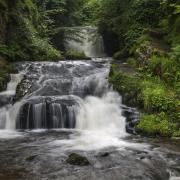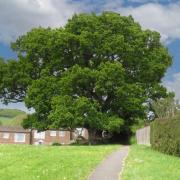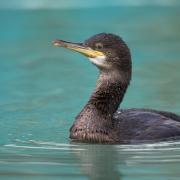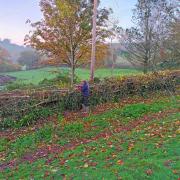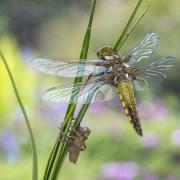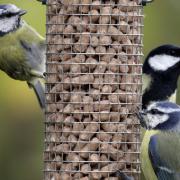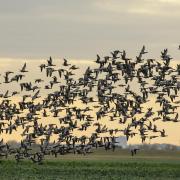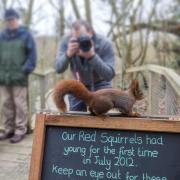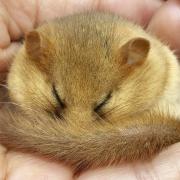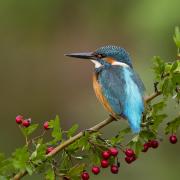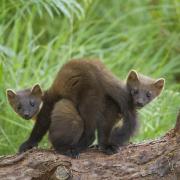The RSPB's Tony Whitehead describes some of the feathered visitors to his Devon garden
I don’t know what it is about them, but I really appreciate the company of the birds in our Devon garden. Through dedicated feeding over the past few years we’ve built up quite a following, and at any given time during the day we can usually spot a small crowd of feathered friends chattering and arguing over the seed and nuts.By number, Goldfinch are the most numerous. Wonderfully colourful little birds, the adults with their red faces and yellow-gold wing bars decorate the hanging feeders like Christmas baubles. Next, by quantity, are the greenfinches. Green, as their name suggests, they always look angry to me. Indeed, befitting this look, they are quite quarrelsome individuals with a keen sense of hierarchy. Both these finches feast by crowding the feeders and it’s not unusual to have well over 20 birds buzzing and flapping around at once.In between these there are the ‘smash and grab specialists’ – blue tits and great tits. Not for them lots of hanging around. Rather, a quick flight in, pick a seed or nut, then fly back to the safety of a nearby branch. With seed held firmly in their feet, a few quick pecks to dispatch and it’s back to the feeder for another raid. Below all this commotion we also have our ground-feeding birds. The blackbird families are amongst our favourites and do get a little spoilt, with the occasional apple cut into slices, accompanied by a scattering of dried mealworms. Alongside these we have our chaffinch posse, scooping up seed fallen from the feeders, and dunnocks flitting in and out of the undergrowth, plus the occasional wren every now and then, passing through looking for spiders no doubt. Top of the list of favourites, and I make no apologies for the choice, are the robins, whose appearance never fails to lift the spirits on even the darkest, coldest and wettest winter days. It’s difficult to put my finger on exactly why I like these birds so much. Perhaps it’s something genetic, as robins have undoubtedly lived alongside us for thousands of years. Without a shred of evidence, I imagine them hopping around the feet of our Celtic ancestors on the nearby iron age hill fort.Like the blackbirds they have a taste for mealworms, especially the live ones we get once in a while, and they are quite happy picking other tiny creepy-crawlies that inhabit our rather wild borders. Their method is similar to the great tits and blue tits. First, they spot something on the ground from the vantage point of a low branch, flutter down to pick it up, then fly back to their vantage point. Technically it’s called ‘ground sallying’, an odd but not unpleasant term.Altogether we’ve seen 23 different species in the garden. About half of those are around most of the time, but the remaining ones are occasional visitors and the ones that cause most excitement. Our latest ‘new’ bird was a redwing, spotted high in the branches of a tall elder at the bottom of the garden. Redwing are winter migrants and not uncommon, but this was the first one we’d seen on our patch… adding to the three other thrushes we’ve had (blackbird, song thrush and fieldfare). We just need the mistle thrush and we’ll have the complete set.Other highlights over the past couple of years have included our resident goldcrest last winter, an impossibly small and delightful creature, the bullfinch family this summer (mum, dad and two youngsters), the hunting sparrowhawk, the occasional great-spotted woodpecker (with a taste for the suet-rich bird cake) and the brambling, a plump finch and winter visitor, common in some years, scarce in others, depending on food resources and weather in northern Europe. I could go on, but I won’t, for fear of this becoming a bit of a boring ‘birds we’ve seen’ list. It is the presence of these creatures that is important to us and we’re really proud that we have them, and there’s a whole lot of people that feel the same. RSPB estimates claim that well over half the population (those with gardens) regularly put food out for the birds. Although they might not reflect on it, I’ll bet it’s just as important to them too.Top of the list of favourites, and I make no apologies for the choice, are the robins, whose appearance never fails to lift the spirits on even the darkest, coldest and wettest winter daysTips for BirdfeedingIf you are thinking of trying to attract more birds to your own backyard, there are a few things to bear in mind:
Be patient First of all, be patient. If you’ve never fed birds don’t expect 30 species to turn up within an hour of hanging your first feeder. You have to put the food out and wait. Eventually our feathered friends will find it and add your garden to their address list.
Variety Try to put out a mix of different foods. Sunflower hearts are one of the best and the finches seem to really go for them. It’s the only food I’ve ever seen our bullfinch eat as well. Peanuts are also good, and in our garden this is what the long-tailed tits go for. You can try other types of seed as well, such as nyger seed, specially for the goldfinches, but remember – everything in moderation. Although it’s tempting, don’t fill your garden with birds seed.Remember, you are supplementing the birds natural diet rather than totally replacing it! Alongside seed, mealworms go down wonderfully in our garden. You can buy them dried, but if you want to offer a truly juicy treat, try some live ones as well. Don’t fill your garden with bird seed. Remember, you are supplementing the birds’ natural diet rather than totally replacing it!Let them eat cake!And then there’s bird cake. This is a mix of fats such as suet and, nowadays, dried insect bits as well. If you have woodpeckers, this is what they will go for. Likewise, it was the only thing our resident goldcrest would eat, probably because of the insect bits. You can also put out sliced apple as well. As I mentioned earlier, the blackbirds love these, but if you have fieldfare around in winter you might tempt them into the garden this way.
A few don’ts There are, of course, a few things you should not do. It almost goes without saying that the tipped-out remains of last night’s Chinese would not be advisable, because some of the oils in the food could coat the birds’ feathers, and also because it might attract unwanted guests such as rats. And avoid food that is likely to swell in a bird’s stomach, dried rice being a good example. Go easy on the bread too. In fact, try and avoid it altogether. Although the birds will eat it, the bread contains no nutritional value and simply wastes their time, time they should be using to fill up on high-energy food such as sunflower seeds.
FeedersFor feeders, think first about where you are going to site them. They should be close to some natural cover so that birds have somewhere to fly to and from safely, but avoid sighting them right in the middle of bushes, where birds might roost, as this prevents them becoming soiled with droppings. Hanging feeders are ideal. When buying them do go for quality and have an eye to how easy they are to dismantle.
This is important because you’ll need to take them apart to keep them clean. You can buy different hanging feeders for different foods such as seeds, peanuts and fat. Alongside these, you might want to place a hanging bird table. We have a couple of these and they are excellent. You can also provide a classic wooden bird table rooted in the ground, but watch out for predators scaling the bird table’s post.
HygieneJust as I wouldn’t like to eat food off a dirty plate, I wouldn’t expect the birds to eat from a dirty feeder because, like us, birds can pick up diseases such as salmonella. To clean feeders, use a simple solution of disinfectant (one part to twenty parts of water) and a brush retained just for the job. Do this outside and, once done, wash and dry hands outside to prevent anything transferring indoors. The same goes for bird tables, and don’t forget to keep the ground beneath the feeders clear by regularly brushing up fallen food.
Don’t forget the waterLastly, don’t forget the water. This is vital. Not only for the birds to drink, but for them to bathe in. A simple bird bath will suffice, but remember to keep it clean, topped up and ice free in winter.There’s always new things to discover about feeding birds, but with all this in place you can sit back, watch and enjoy! Do check out the RSPB’s website, it’s packed with information about garden birds and it has a great bird identification section too.
RSPB Annual Birdwatch If you want to share what’s in your garden with others, don’t forget to take part in the RSPB’s annual Big Garden Birdwatch. Held annually, on the last weekend in January, this national survey now attracts over half a million participants. For the Big Garden Birdwatch, visit www.rspb.org.uk/birdwatch.
For other enquiries contact the RSPB Exeter office on 01392 432691. To find out more, visit www.rspb.org.uk.



